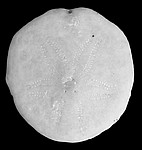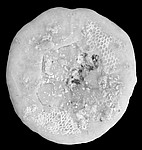Echinarachniidae
Lambert, 1914 (emend. Durham, 1955)
Genre type : Echinarachnius Gray,1855
Description succincte de la famille : Présence de piliers internes, périprocte supra-marginal à oral. Sillons nourriciers formant une ligne perradiale jusqu'à la seconde basicoronale, au-delà de laquelle ils se ramifient.

|
Genus ASTRODAPSIS Conrad (amended). Astrodapsis Conrad, 1869, Acad. Nat. Sci. Philadelphia Proc., vol.8, p.315. Astrodapsis Conrad, 1857, U.S. Pacific R. R. Expl., vol.7, Pal. Rept., p.196. Astrodapsis Rémon, 1863, California Acad. Nat. Sci. Proc., vol.3, p.52. The writer does not agree with Duncan in regarding Conrad's genus Astrodapis as a synonym of Breynius's genus Arachnoides. The inframarginal position of the periproct, the depressed apical system, and the elevated ambulacral areas alternating with deressed interambulacral areas sufficiently distinguish Astrodapsis from Arachnoides. Conrad's description of his genus is as follows : "Suboval ; depressed ; ambulacral areas elevated or ridged ; ambulacra nearly straight, widely open at the extremity ; mouth central ; anus submarginal, beneath ; radiating grooves as in Laganum." This description was good in view of the small amount of
|
material Conrad had, but it now
becomes necessary to redraw the diagnosis of the genus in order to
make a few emendations. Description. - Test depressed, subdiscoidal to broadly subconical in general form, circular to subelliptical in marginal outline, margin varying from thin to very thick, with or without notches opposite the ambulacral petals. Ambulacral areas elevated or ridged ; interambulacral areas depressed. Ambulacral petals straight, extending nearly to the margin, widely open at the ends ; poriferous zones nearly parallel, continuously diverging, or diverging, converging, and again diverging. Apical system mor or less depressed. Peristome central or subcentral. Main ambulacral grooves simple and straight from peristome to margin, continuing as fainter grooves or precesses over the margin and along the middle of the ambulacral ridges nearly to the apical system ; two faint lines or processes are given off from the main grooves from one half to two thirds the way to the margin, which continue over the margin and along the upper surface between the tops of the ambulacral ridges and the bottoms of the ambulacral depressions nearly to the apicalsystem. Periproct small, inframarginal, almost marginal. |
![]()
diagnose originale de l'espèce (et du genre) par Conrad, 1856
Descriptions of three new genera ; twenty-three new spcies Middle Tertiary Fossils from California, and one from Texas, p.312
|
Echinoderms ASTRODAPSIS, Conrad. Suboval, despresed ; ambulacral areas elevated or ridged ; ambulacra nearly straight, widely open at the extremity ; mouth central, anus submarginal, beneath ; radiating grooves as in Laganum. Astrodapsis Antiselli. Pentangular, suboval ; ambulacral ridges rounded on the back, straight and oblique on the sides ; interambulacral areas profoundly depressed, angulated in the middle ; point of divergence of the ambulacra depressed below the level of the ridges, not quite central, but anterior to the middle ; anus small, almost marginal. Lengh 1 3/4 inch. Locality. Monterey Co., Cal. A. S. Taylor. |
description de l'espèce (et du genre) par Clark & Twitchell, 1915
Mesozoic and Cenozoic Echinodermata ot the United States, p.198
|
Astrodapsis antiselli
Conrad. Plate XCIV, figures 3,
4a-b. Determinative characters.—Test medium in size; regularly oval in marginal outline, longer than broad, slightly truncated at anterior end, slightly pointed at posterior end, with faint notches opposite ends of petals; margin roimded and very thick, ahnost as thick as rest of test. The whole form is considerably depressed, almost equally so from edge to edge, and therefore subdiscoidal; the upper surface with broad, flattened ambulacral ridges alternating with narrow interambulacral depressions; apex excentric anteriorly, in front of depressed apical system; lower surface shghtly concave. Ambulacral petals large, broad, tumid, especially near apical system ; poriferous zones narrow, at first diverging, then converging slightly from one-fourth to one-third the way to the margin, and again diverging to the wide-open ends which are nearly at the margin. Peristome central; the main ambulacral grooves straight, well defined, and rather deep from peristome to margin and continuing as faint lines over margin to near apex, two faint Unes are given oflf about halfway to margin, which continue over margin to near apical system. Periproct small, inframarginal, almost marginal. Dimensions.—Specimen B: Length 57 millimeters ; width 50 miUimeters; height 14 millimeters. Description.—This species was one of the first of the Tertiary echinoids to be reported from the Pacific coast of the United States, having been described by Conrad as early as 1856. Conrad founded his new genus Astrodapsis upon this species. The test is medium in size, averaging about 2 inches in length. In mai-ginal outUne it is regularly oval, longer than broad, usually slightly truncated at the anterior end and somewhat pointed at the posterior end, with very slight notches opposite the ends of the petals ; margin rounded and very thick, almost equal in thickness to the rest of the test, somewhat thicker anteriorly than posteriorly. The whole form considerably depressed, subdiscoidal; the upper surface with broad flattened ambulacral ridges alternating with narrow interambulacral depressions; apex excentric anteriorly in front of apical system; under surface shghtly concave. The ambulacral areas are wide; dorsal portions petaloid. The petals are large, broad, tumid, widest and most tumid near the apical system, constituting broad ridges, all of them extending nearly to the margin, wide open at the ends ; interporiferous areas very wide ; poriferous zones narrow and of nearly equal breadth throughout their length, at first diverging, then converging shghtly from one-fourth to one-third the way from the mai^in, and again diverging; inner row of pores round, outer row broadly shthke, paire of pores conjugated. The interambulacral areas are narrow, decidedly depressed, forming radial grooves in the upper surface. The whole surface of the test is covered with small but conspicuous tubercles, which make the surface feel rough; they are larger and more conspicuous in the interporiferous areas. The apical system is shghtly excentric anteriorly, in a star-shaped depression below the level of the ambulacral ridges. There appear to be only four genital pores wliich are located at four of the points of the star-shaped depression. No further details could be made out. |
The peristome is central, circular to subpentagonal. The main ambulacral gi-ooves are straight, well defined and rather deep from peristome to margin and continue as faint lines over the margin and along the middle of the ambulacral ridges to the apical system; two faintly defined processes are given off about halfway from the peristome to the margin, whicli extend to and over tlie margin and on the upper surface between the top of the ridges and the bottom of the depressions, becoming indistinct as the apical system is approached. The periproct is small, subcircular, inframarginal, almost marginal. Related forms.—Duncan' regarded Conrad's genus Astrodapsis as a synonym of Breynius's genus Arachnoides; but, though there are certain points of resemblance, the inframarginal position of the periproct, the more or less depressed apical system and the elevated, ridgelike ambulacral areas alternating with depressed groovelike interambulacral areas on the upper surface would appear to sufficiently differentiate the genus Astrodapsis. The present species is readily separated from the other representatives of the genus, although some confusion has arisen in the literature and in various collections because of the obscure location of Conrad's description and figures. A. whitneyi differs in being broadly subconical and in ha%ang a thin margin, more circular outline, more pronounced marginal notches, higher ambulacral ridges and deeper interambulacral depressions. A. tumidus differs in being smaller and in having a greater difference between the height of the ambulacral ridges and interambulacral depressions. Localities.—Monterey County (type), and 2 miles south of San Lucas, Monterey County (specimen B), Cal. Conrad also cites Estrella, and Gabb gives near Buena Vista Lake, both in Califorma. Geologic horizon.—Santa Margarita formation, middle or upper Miocene. Collection.—U. S. National Museum (165466, A; 16.5466a, B). (Both the type and the specimens collected by Arnold, which include specimens A and B.) planche XCIV (extrait)
|
|
Astrodapsis antiselli Conrad,1856 - Miocène, Santa Margarita Sandstone, San Luis Obispo, Californie, U.S.A., 51 mm |
|
Astrodapsis antiselli Conrad,1856 - Miocène, Santa Margarita Sandstone, San Luis Obispo, Californie, U.S.A., 38 mm |
![]()
description de l'espèce par Clarck & Twitchell
Mesozoic and Cenozoic Echinodermata of the United States, 1915, p.199
|
ASTRODAPSIS ARNOLDI Twitchell, n. sp. Plate XCV, figure 1. Astrodapsis withneyi Arnold, 1909, I.S. Geol. Survey Bull. No.396, p.63, Pl. XI, fig. 1. Astrodapsis antiselli var. arnoldi Pack, 1909,California Univ. Dept. Geology Bull., vol. 5, No. 18, pp. 279-281, Pl. XXIV, figs. 1,2. Astrodapsis whitneyi Stefanini, 1911, pars, Soc. geol. italiana Boll., vol. 30, p. 703. Determinative characters. - Test large, larger than most representatives of the genus ; circular in marginal outline ; margin and wide submarginal area notably thin, undulating, with pronounced posterior notches and less pronounced anterior notches. The whole form considerably depressed, greatly and nearly equally so for half the distance from margin toward the center, moderately elevated centrally, with rather broad and somewhat flattened ambulacral ridges alternating with broad deep interambulacral depressions. The inner ends of the ambulacral ridges almost coalesce around the slightly depressed apical system and form the somewhat flattened subcentral apex of the test. Lower surface flat or nearly so. Petals moderately wide, elongate subelliptical, nearly reaching the margin where wide open ; inner halves elevated and tumid, outer halves depressed and merging with submarginal area ; inner rows of pores of each petal nearly parallel for most of their length. Peristome small, circular, central ; main ambulacral grooves simple, straight and deep to the margin, continung as faint lines straight and deep over margin and along middle of ambulacral ridges nearly to apex ; two faint proceses are given off about half way to margin which continue over margin and on upper surface to near the apex. Periproct very small, inframarginal, almost marginal. Dimensions. - Length 76 millimeters ; width 75 millimeters ; height 10 millimeters. Description. - The test of this new Astrodapsis is unusually large. In marginal outline it is circular ; the margin is markedly thin, undulating, with well-defined notches opposite the ends of the petals, the posterior notches being slightly larger than the anterior pair, which are larger than the odd one ; the submarginal area for nearly half the way toward the center is also thin, about as thin as at the margin. Centrally, within the area circumscribed by the thin and flattened submarginal area, the upper surface is moderately elevated with rather broad and somewhat flattened ambulacral ridges alternating with broad deep interamb ulacral depressions, the central elevation being flattened on top around the slightly depressed apical system. The ambulacral ridges almost coalesce around the apical system. The apex is central or subcentral ; the lower surface flat or but very slightly concave from margin to center. The interambulacral areas are wide, slightly wider at the margin than the interambulacral areas, narrowing rapidly to a point about midway between the margin and the center of the test, where narrower than the interambulacral areas ; dorsal portions petaloid. The petals are of moderate width, elongate subelliptical, long, nearly reaching the margin, the inner half of each petal elevated, tumid but somewhat flattened on top, the outer half depressed, gradually broadening and merging with the flattened submarginal area ; the poriferous zones are narrow, the inner rows of pores nearly straight and parallel for most of their length, wide apart at the ends, composed of large, round openings ; outer rows diverging for about half the distance to the margin |
then drawing near inner rows, pores slitlike pairs of pores conjugated. The surface of the odd petal is slightly higher than that of the anterior pair, which is slightly higher than that of the posterior pair. The interambulacral areas at the margin are somewhat narrower than the ambulacral areas, near the apex they are much narrower, almost obliterated ; they become depressed rather rapidly from near the apex to about halfway to the margin, whence they merge with the flattened submarginal area, though keeping slightly more depressed than the adjacent ambulacral areas. The surface of the test is covered with small but rather conspicuous tubercles, most conspicuous in the interporiferous areas. The apical system is central, slightly depressed below the top of the ambulacral ridges. The details could not be made out on the specimen studied. The peristome is small, circular, central. The main ambulacral grooves are simple, straight, and deep from peristome to margin ; they continue as faint lines over the margin, and along the middle of the ambulacral ridges nearly to the apex ; two faintly defined processes are biven off about halfway from peristome to margin which extend to and over the margin and along the upper surface between the top of the ridges and the bottom of the depressions, near the suture line between the ambulacral and interambulacral plates, disappearing near the inner ends of the interambulacral depressions. The periproct is very small, inframarginal, almost marginal. Related forms. - A. arnoldi is most closely related to A. whitneyi. In fact specimens of eah species answer to Rémond's description, and in view of the loss o Rémond's type it is not possible to be sure which form was really his. Merriam, evidently influenced by Gabb's figure, and before Arnold's and Pack's specimens were discovered, redescribed and figured as A. whitneyi the broadly subconical form. Arnold's specimen, with the arch of the upper surface commencing some distance in from the edge, was identified by him as an Astrodapsis whitneyi. Pack describes and figures a specimen which is evidently identical with that of Arnold just referred to but errs in treating it as a variety of A. antiselli, from which it differs considerably, in fact, much more than it does from the A. withneyi of Gabb and Merriam. The present form, represented by the specimens of Arnold and of Pack, appears to be entitled to recognition as a distinct species, and as the writer agrees with Merriam in regarding the broadly subconical form figured by Gabb as most probably Rémond's A. whitneyi the present species is named after Arnold, who collected the type in the Coalinga district, California. A. arnoldi is readily distinguished from A. whitneyi in having the arch of the upper surface notably thin, also in having the outer portions of the petals greatly depressed and merging with the submarginal area, and the ambulacral ridges somewhat broader and more flattened near the apex. A. antiselli has its apical region much more depressed, and into this depression extend the interambulacral depressions ; the odd petal is higher and more conspicuous and the inner lines of pores of the petals diverge instead of being nearly parallel. Localities. - Above Big Blue, west of Peerless Oil property, 9miles north of Coalinga (type), and Salinas Valley, Monterey County, Cal. Geologic horizon. - Santa Margarita formation, middle or upper Miocene. Collections. - U.S. National Museum (165594) ; University of California.
|
|
Astrodapsis arnoldi (Pack, 1909) - Miocène, Pancho Rico Form., Monterrey Cty, Californie, 44 mm |
||||||
|
||||||
|
||||||
![]()
diagnolse originale de l'espèce par Kew, 1915
Tertiary echinoids from the San Pablo Group of Middle California, p.6 [370]
|
ASTRODAPSIS TUMIDUS, Rémond, n. subsp. CIERBOENSIS Plate 39, figures 5a, 5b Test subcircular to elliptical in outline ; strongly depressed ; margins thickened and rounded ; some specimens slightly notched at the ambitus in the posterior ambulacral areas. Apical system central and somewhat sunken. Summit anterior to apical system. Ambulacra petaloid ; petals slightly elevated, broad, and wide open at their extremities. Pores conjugate. Inner rows of rounded pores contract slightly about two-thirds the distance from the apical system to the margin ; outer rows of elongated pores also converge close to the inner rows at the same place and then continue to the ambitus parallel with the inner rows ; in some cases the pores extend on the under surface. Anus marginal. Inferior surface concave, with no ambulacral furrows, except in occasional specimens where brroad indistinct grooves and bifurcating ambulacral lines are present, the latter extending on the upper surface. Astrodapsis tumidus, n. subsp. cierboensis shows distinct intergradational characters between Scutella (?) breweriana Rémond and Astrodapsis tumidus Rémond. Astrodapsis t. cierboensis is distinguished from Scutella (?) breweriana mainly by its raised petals ; but specimens of the latter sometimes have this character. Both forms have a tendency to take an alliptical shape, and the petals have wide poriferous areas. In no case does Scutella (?) breweriana have interambulacral depressions, while a few specimens of Astrodapsis t. cierboensis possess incipient ones. The main differences between Astrodapsis t. cierboensis and Astrodapsis tumidus are, that the margin is much thicker in the former ; the ambitus is not so strongly notched in the ambulacral areas ; the petals |
and poriferous areas are usually broader ; the interambulacral depressions are absent or slight ; the ambulacral furrows are very indistinct or absent ; and the tubercles are not so prominent. It also differs from Scutella pabloensis, n. sp., in that the margin of the latter is more strongly notched and thicker, and the test has larger tubercles. Occurence. - Lower San Pablo group above the lower Scutella gabbi zone. It is found with Scutella pabloensis, n. sp. It also occurs in the lower part of the Santa Margarita formation. Average measurements. - anteroposterior diameter, 36 mm. ; transverse diameter, 32 mm. ; greatest thickness, 9.5 mm. planche 39 (extrait)
|
|
Astrodapsis cierboensis Kew,1915 - Branch Canyon Formation, Miocène, Cuyama Valley, San Luis Obispo Cty, Californie, U.S.A., 27 mm |
![]()
description de l'espèce par Clarck & Twitchell
Mesozoic and Cenozoic Echinodermata of the United States, 1915, p.201
|
Astrodapsis whitneyi Rémond. Plate XCV, figure 2a-c. Astrodapsis withneyi Rémond, 1863, California Acad. Nat. Sci. Proc., vol.3, p.52 ; no figure. Astrodapsis whitneyi Meek, 1864, Smithsonian Misc. Coll. vol.7 (183), p.2. Astrodapsis whitneyi Gabb, 1869, California Geol. Survey Rept., Paleontology, vol.2, pp.37, 110, Pl.XIII, figs.67, 67a. Astrodapsis whitneyi Cooper, 1888, State Mineralogist of California Seventh Rept., p.271. Astrodapsis whitneyi Merriam, 1899, California Acad. Sci. Proc., 3d se., Geology, vol.1, No.5, p.167, Pl.XXI, figs.4, 4a. non Astrodapsis whitneyi Arnold, 1909, U.S. Geol. Survey Bull. 396, p.63, Pl.XI, fig.1 Astrodapsis whitneyi Stefanini, 1911, Soc. geol. italiana Boll., vol.30, p.703. Determinative characters. - Test medium to large ; circular in marginal outline, broadly subconical in general form ; margin thin, with small subequal ambulacral notches. Upper surface rising directly from margin to the relatively high, slightly anteriorly excentric apex ; with high, narrow, steep-sided ambulacral ridges alternating with broad, deep interambulacral depressions. Lower surface concave. Petals relatively narrow, elongate subelliptical, nearly reaching margin, wide open at ends ; inner rows of pores nearly parallel for most of their lenght. Apical system slightly excentric anteriorly, faintly depressed below top of petals. Peristome central ; main ambulacral grooves simple, straight, and deep to the margin, continuing as faint lines on upper surface nearly to apex ; two faint processes given off about halfway to margin, which also continue to and over margin and on upper surface nearly to apex. Periproct small, subcircular, inframarginal, almost marginal. Dimensions. - Length 50 millimeters ; width 50 millimeters ; height 13 millimeters. Description. - This species was one of the first fossil echinoids to be reported from the California Tertiary deposits, having been described, but not figured, by Rémond in 1863. The test is medium to large, ranging, according to Merriam, up to 65 millimeters in diameter. In marginal outline it is circular ; margin thin, with small but well-defined, subequal notches opposite all the ambulacral petals. The whole form is depressed, but less so than in related species, the upper surface being broadly subconical, rising directly from the margin to the relatively high, slightly anteriorly excentric apex ; with high, narrow, steep-sided ambulacral ridges alternating with broad, deep, interambulacral depressions. The under surface is concave, the concavity gradually deepening to the peristome, where it is about one-third of the height of the test.
|
The ambulacral areas are wide, wider than the interambulacral areas ; dorsal portions petaloid. The petals are relatively narrow, elongate subelliptical, long, nearly reaching the margin ; the poriferous zones are narrow, about half as wide as the tumid interporiferous areas, the inner rows of pores elevated, nearly straight, and parallel for most of their length, wide apart at the ends, composed of large, round openings ; outer rows depressed, diverging for about half the distance to the margin, then drawing near the inner rows, pores slitlike ; pairs of pores conjugated ; several pairs of pores occur beyond and diverge from the ends of the petals. The interambulacral areas at the margin are somewhat narrower than the ambulacral areas ; near the apex they are much narrower, almost obliterated ; they are gradually depressed from near the apex to the margin. The surface of the test is covered with small, inconspicuous tubercles, varying in size and set in shallow scrobicules ; the tubercles ar somewhat larger in the interporiferous areas than elsewhere. The apical system is slightly excentric anteriorly, faintly depressed balow the tops of the ambulacral petals. The details could not be made out on the specimen. The peristome is central, The main ambulacral grooves are simple, straight, and deep from peristome to margin ; they continue as fainter lines over the margin and along the middle of the ambulacral ridges nearly to the apex ; two faintly defined processes are given off about halfway from peristome to margin, which extend to and over the margin and on the upper surface between the tops of the ridges and bottom of the depressions. The periproct is very small, subcircular, inframarginal, almost marginal. Related forms. - As the location of the type is unknown, some doubt exists as to the exac form which should be called A. whitneyi. The species described under the name of A. arnoldi (p.199) agrees with Rémond's description of A. whitneyi as well as if not slightly better than that described and figured by Merriam as A. whitneyi, which is here adopted. However, Gabb figured as A. whitneyi a specimen similar to the present form, and the writer here follows Merriam in regarding it as probably similar to Rémond's original form. A. whitneyi is most closely related to A. arnoldi, which differs in having the arch of the upper surface commence nearly halfway in from the margin to the center, in having a markedly thin margin and submarginal area, and the outer half of each petal greatly depressed and merging with the submarginal area. A. whitneyi is also closely related to A. jacalitosensis, which differs in much the same way as A. arnoldi, and further in having a more deeply depressed apical system, the interambulacral depressions extending to and joining the apical depression, and the inner line of pores of the petals diverging. A. whitneyi is also allied to A. tumidus, which is smaller, has a thicker margin, and a less definitely broadly, subconical upper surface. Localities. - Kirkers Pass, north of Mount Diablo, and south shore of San Pablo Bay, Cal. Geologic horizon. - San Pablo formation (upper part), upper Miocene. Collection. - University of California (19426).
|
Hypotypes conservés à University of California Museum of Paleontology
![]()
|
Astrodapsis whitneyi Rémond, 1863 - Miocène supérieur, Branch Canyon formation, Santa Barbara County, Californie, 66mm |
![]()
description de l'espèce par Hall
Evolution of the echinoid genus Astodapsis, 1962, p.69
|
Astrodapsis davisi Grant & Eaton, 1941 (Pl.8, figs.1-8 ; pl.9, figs.1-8 ; pl.10, figs.1-4, 6, 8 ; pl.11, figs. 1-8 ; pl.12, figs. 1-10 ; pl.13, figs.1-10 ; pl.14, figs.5, 7) Astrodapsis davisi Grant and Eaton, 1941, Amer. Assoc. Petrol. Geol. Bull., vol.25, pl.7, fig.3. Astrodapsis davisi Grant and Eaton, 1941, ibid., pl.7, fig.7. Astrodapsis englishi Grand and Eaton, 1941, ibid., pl.6, fig.7. Astrodapsis clarki Grant and Eaton, 1941, ibid., pl.7, fig.1. Astrodapsis desaixi Grant and Eaton, 1941, ibid., pl.6, fig.5. Astrodapsis gregerseni Grant and Eaton, 1941, ibid., pl.6, fig.4 ; Durham, 1955, Univ. Calif. Pub. Geol. Sci., vol.31, no.4, pp.106, 168, fig.22e. Astrodapsis gregerseni var. fragilis Grant and Eaton, 1941, ibid., pl.6, fig.2. Astrodapsis gregerseni var. varians Grant and Eaton, 1941, ibid., pl.6, fig.8. Astrodapsis goudkoffi Grant and Eaton, 1941, ibid., pl.6, fig.6. Astrodapsis isabellae Grant and Eaton, 1941, ibid., pl.7, fig.2. Astrodapsis johnsoni Grant and Eaton, 1941, ibid., pl.6, fig.3. Astrodapsis johnsoni var. simile Grant and Eaton, 1941, ibid., pl.6, fig.3a. Astrodapsis major var. parens Grant and Eaton, 1941, ibid., pl.7, fig.6. Astrodapsis margaritanus Kew, Grant and Eaton, 1941, ibid., pl.7, fig.4. Astrodapsis quaylei Grant and Eaton, 1941, ibid., pl.6, fig.9. Astrodapsis tumidus Rémond, Grant and Eaton, 1941, ibid., pl.8, fig.2 Holotype. - Univ. Calif., Los Angeles, Cat. no. 8845.3 UCLA loc. no. 1729. Paratypes. - Univ. Calif., Los Angeles, Cat. nos. 8805, 8810, 8815, 8820, 8822, 8825, 8835, 8840, 8843, 8844, 8845, 8846, 8848, 8850, 8860, 8865, 9210, 9211, 9212, 9215, 9216, 9217, 32376, 32377. |
Type locality. - "White reef beds just below unconformity in Discovery Gulch. Zone 8F (middle and upper)" (from UCLA locality book). Locality 1729 shown on Eaton, Grant and Allen map (1941, fig.13), 1,650 feet due south of "H" in Branch Canyon. Shown as uppermost "Cierbo". Occurence. - "Upper Cierbo-Lower Neroly of Eaton et al. (1941). Upper Mohnian to lowermost Delmontian. Description. - Test moderately large ; usually somewhat elongate and faintly subpentagonal or rounded subpentagonal in ourline ; margins of moderate thickness, usually but slightly indented at the bivium ; periproct inframarginal, but very close to the margin ; petals moderately elevated ; interambulacra flat or gently arched, but depressed below the ambulacra. Measurements. - Holotype. Length, 50.7 mm. ; width, 43.8 mm. ; height, 11 mm. Remarks. - A. davisi Grant and Eaton is the most characteristic of a number of generally similar forms named by Eaton et al. (1941) and is selected as the type of this group. They also named a number of species with gerontic characteristics such as extremely raised petals and excessively developed basicoronal interambulacral plates (see Durham, 1955, pp.106 and 168). Gradational variation from the typical A. davisi to the gerontic forms can be clearly shown. The species in general is characterized y a near-marginal periproct, petals becoming more open and wider in some variations, flattish or gently arched abord interambulacra, moderately thick margins, test flat to conical in shape, and bivium slightly notched ; the trivium may be slightly notched or unnotched. The older gerontic forms ar similar to the slightly younger gerontic forms of this species, with the exception that the periproct is clearly marginal. A. davisi is differentiated from thick-margined variants of A. whitneyi by a periproct that is closer to the margin and by the flat, flat-depressed, or gently arched interambulacral areas. It is generally smaller. It is differentiated from A. pabloensis by the wider petals and generally by a near-marginal rather than a marginal Periproct. This form is intermediate between A. pabloensis and the thick-margined variants of A. whitneyi, and a few variants within a gradational sequence of several specimens of A. davisi are inseparable from one of the two mentionel species. Age. - Late Miocene, lowermost Delmontian, and possibly uppermost Mohonian. |
|
Astrodapsis davisi Grant & Eaton, 1941 - Miocène supérieur, Branch Canyon formation, Santa Barbara, Californie, 55mm |
![]()
|
Astrodapsis spatiosus Kew, 1920 - Miocène supérieur, Sta Maria formation, Scotts Valley, Santa Cruz Cty, Californie, 47 mm |

|
Proescutella. Discoïde, très plat. Pétales très longs, étroits, ouverts, à zones porifères effilées au bout. Les zones ambulacraires sont très élargies au pourtour et resserrent les interambulacres en forme de pétales ; les sillons ambulacraires inférrieurs sont obsolètes ; le périprocte est infra-marginal à une |
petite distance du bord. Le type est P. Caillaudi (Cott. sub Scutella) du terrain éocène. Scutella tetragona Grat., également éocène, en paraît être une deuxième espèce.
|
![]()
|
28 Sismondia Cailliaudi, Cott., 1861. - Haut. 4 mill. ; diam. transv., 18 mill. ; diam. antéro-post., 19 mill. Espèce de petite taille, un peu plus longue que large ; ambitus subpentagonal, anguleux en avant, subtronqué en arrière ; face supérieure déprimée, légèrement renflée sur les bords ; face inférieure plane, subconcave au milieu. Sommet central. Etoile ambulacraire largement développée, composée de pétales égaux, allongés, très ouverts à leur extrémité ; zones porifères formées d'une rangée interne et presque droite de pores arrondis, et d'une rangée de pores obliques, allongés, conjugués par un sillon. Tubercules petits, abondants, scrobiculés, épars. Péristome central, décagonal, dépourvu de bourrelets. Périprocte petit, circulaire, très éloigné du péristome, s'ouvrant à 1 ou 2 millimètres au plus du bord postérieur. Rapports et différences. - Cette espèce, remarquable par sa forme subpentagonale, sa face supérieure déprimée et légèrement renflée sur le bord, présente au premier aspect quelques ressemblance avec le Sismondia
|
occitana, si fréquent dans le calcaire grossier de Pouillac et de Saint-estèphe ; il s'en distingue cependant par sa forme générale moins épaisse et moins renflée, par sa face inférieure plus sensiblement concave, et surtout par la position de son périprocte très rapproché du bord postérieur, tandis que dans le Sismondia occitana il occupe, à la face inférieure, à peu près le milieu de l'aire interambulacraire impaire. Loc. - Campbon (Loire Inférieure). Asez rare. Terrain tertiaire éocène. Musée de Nances. - Pl.1, fig.16, Sismondia Cailliaudi vu de côté ; fig.17, le même vu sur le face sup. ; fig.18, le même vu sur la face inf.
|
|
N° 217. - Praescutella cailliaudi (Cotteau), Pomel, 1883. Pl.265 et 266. Scutella Cailliaudi, Cotteau, Echin. nouveaux ou peu connus, 1re série, p.46, pl. VII, fig.3-5, 1861. Scutella, N. Sp. D'Archiac, Note sur les foss. recueillis par feu le marquis de Boissy au plateau du Four (Loire Inférieure), Bull. Soc. géol. de France, 2e sér., t. XVIII, p.667, 1861. Scutella Cailliaudi, Vasseur, Recherches géol. sur le terrain tert. de la France occidentale, p.93 et passim, 1881. Praescutella Cailliaudi, Pomel, Classification méth. et genera des Echin. viv. et foss., p.70, 1883. Espèce de taille moyenne, presque aussi large que longue, subcirculaire, arrondie en avant, un peu onduleuse et subtronquée en arrière. Face supérieure renglée au milieu, déprimée et presque tranchante sur les bords. Face inférieure plane. Sommet ambulacraire un peu excentrique en avant. Aires ambulacraires pétaloïdes, presque égales, très ouvertes, les aires postérieures plus courtes que les autres, l'aire antérieure paraissant un peu plus longue et plus étroite. Zones porifères larges, effilées, formées de pores inégaux, les internes arrondis, les externes unis par un sillon, disposés par paires obliques. Zone interporifère plane, un peu plus développée que l'une des zones porifères. Les plaques ambulacraires s'élargissent au fur et à mesure qu'elles se rapprochent de l'ambitus et donnent aux aires interambulacraires, sur la face supérieure, une forme pétaloïde très prononcée. Tubercules petits, serrés, un peu plus gros à la face inférieure, aux approches du péristome. Sillons ambulacraires droits, non bifurqués, toujours apparents. Péristome s'ouvrant au milieu de la face inférieure, pentagonal, à fleur de test. Périprocte petit, irrégulièrement arrondi, placé à quelque distance du bord postérieur. Appareil apical assez grand, muni de quatre pores génitaux situés sur le bord de la plaque génitale qui est un peu bombée, les deux pores antérieurs plus rapprochés que les deux autres ; cinq petites plaques ocellaires distinctes. Certains exemplaires permettent de voir les cloisons ou piliers qui garnissent l'intérieur du test aux approches de l'ambitus ; ils sont nombreux, transverses et régulièrement disposés ; la partie supérieure du test et l'espace occupé par les aires ambulacraires en sont dépourvus. Dans l'intérieur du test, les aires ambulacraires paraissent moins larges et plus effilées que sur la face externe. Ce caractère avait engagé d'Archiac à séparer de notre Scutella Cailliaudi, de Machecoul, des exemplaires provenant du plateau du Four, qu'il considérait comme formant une espèce particulière. Cette différence est plus apparente que réelle, et nous ne voyons qu'une seule et même espèce dans les nombreux exemplaires que possède le musée de Nantes, et que M. Bureau nous a communiqués. Nous rapportons au P. Cailliaudi un exemplaire de très petite taille, rencontré par M. Dumas près de Cambon, dans une carrière à l'est de Toas : se forme est pentagonale et sa face supérieure régulièrement bombée ; ses aires ambulacraires, formées de pores petites et inégaux, sont effilées et cependant très ouvertes ; le péristome est subpentagonal et relativement assez grand. Le périprocte, irrégulièrement arrondi, est un peu plus éloigné du bord postérieur. Malgré cette différence, ce petit exemplaire ne saurait être distingué du type. Nous avons fait grossir la face inférieure, qui montre parfaitement la structure des plaques ambulacraires et interambulacraires, et la place très restreinte occupée par ces dernières. |
Nous connaissons cette espèce à ses différents âges. En dehors de sa forme qui est plus ou moins nettement circulaire, elle varie peu dans l'ensemble de ses caractères : les aires ambulacraires, dans certains exemplaires paraissent plus ouvertes et dans d'autres plus effilées, mais les différences sont peu apparentes et sont reliées entre elles par des passages insensibles. Rapports et différences. - Le P. Cailliaudi sera toujours reconnaissable à sa forme subcirculaire ; à sa face supérieure légèrement bombée et amincie sur les bords ; à la largeur de ses zones porifères très effilées cependant à leur extrémité ; à l'étendue de ses plaques ambulacraires vers l'ambitus ; à son péristome nettement pentagonal ; à son périprocte irrégulièrement arrondi ; à la disposition des piliers transverses qui garnissent l'intérieur du test, vers l'ambitus. Localités. - Machecoul, île Saint-Michel à l'ouest de Machecoul, îlot de la Bauche, plateau du Four, Arthon, Les Rochettes, Saffré, La Close, bassin de Cambon (Loire Inférieure) ; Bouin (Vendée). Eocène moyen, zone inférieure et zone supérieure. Muséum de Nantes, collection de la Sorbonne (Hébert, Vasseur), Dumas, Gauthier, P. de Loriol, Cotteau. Explication des figures. - Pl.265, fig.1, P. Cailliaudi, type de l'espèce, vu sur la face supérieure (figure copiée, ainsi que la suivante, sur la pl. VII, 1re sér. des Echin. nouveaux ou peu connus, fig. 3 et 4) ; fig. 2, le même vu de côté ; fig. 3, autre exemplaire, du plateau du Four, du muséum de Nantes, vu sur la face supérieure ; fig. 4, aire ambulacraire grossie ; fig. 5, pores plus fortement grossis ; fig. 6, individu plus jeune, du muséum de Nantes (coll. Dufour), vu de côté ; fig. 7, face supérieure ; fig. 8, face inférieure ; fig. 9, péristome grossi ; fig. 10, individu jeune, du muséum de Nantes, vu sur la face supérieure ; fig. 11, face inférieure ; fig.12, appareil apical, pris sur un autre individu du muséum de Nantes, grossi. - Pl.266, fig.1, P. Cailliaudi, des Rochettes, de ma collection (M. Vasseur), vu sur la face supérieure ; fig. 2, autre exemplaire, de la même localité, vu de côté ; fig. 3, face inférieure ; fig. 4, autre exemplaire, de Bouin, du muséum de Nantes (coll. Dufour), vu sur la face supérieure ; fig. 5, le même exemplaire, montrant la face supérieure interne et les cloisons dont elle est munie, aux aproches de l'ambitus ; fig. 6, aire ambulacraire, prise à la face supérieure du même échantillon, grossie ; fig. 7, aire ambulacraire, prise sur la face interne, grossie et montrant que sa forme est plus effilée ; fig. 8, la face supérieure, grossie ; gig. 9, autre individu très jeune et à forme plus pentagonale, de Cambon (Coll. Dumas), vue de côté ; fig. 10, face supérieure ; fig. 11, face inférieure ; fig. 12, face inférieure, montrant la disposition des plaques ambulacraires et interambulacraires, grossie.
|
|
Proescutella cailliaudi (Cotteau,1861) - Lutétien, Le Bois Gouet, Safré, Loire Atlantique, 31 mm |
|
Proescutella cailliaudi (Cotteau,1861) - Lutétien, Le Bois Gouet, Safré, Loire Atlantique, 32 mm |
|
Proescutella cailliaudi (Cotteau,1861) - Lutétien, Loire Atlantique, 20 mm |

![]()
|
Scutellaster interlineata (Stimpson, 1856) - Pliocène supérieur, San Francisco, Californie, USA, 73 mm |
spécimens munis de leurs soies

![]()
|
Taiwanaster mai Wang,1984 - Pléistocène, Maioli, Taiwan, 10 mm |

![]()
|
Astrodapsis merriami n. sp. Plate XIV, Figs. 33 and 34. Disk small, circular, depressed ; margin only slightly notched at the ambulacral extremities ; apex central, only slightly elevated, star symmetrical, petals equal but not reaching the margin of the disk, and slightly elevated ; anal pore marginal ; ambulacral furrows of inferior surface straight and simple. The largest specimens have a diameter of 11/2 inches, though the usual size is three-fourths of an inch. The disk is thin and flattened but shows a decided tendency to form elevated stars on the upper surface.
|
Occurence. - This form is extremely abundant locally in the Temblor Beds of the Mount Diablo Range, at Tar Springs, Kreyenhagen's, and Temblor. |
|
Scutella (?) merriami (Anderson) Plate LXXXV, figures 7a-c, 8a-b Astrodapsis merriami F.M. Anderson, 1905, California Acad. Sci. Proc. 3d ser. Geology, vol.2, No.2, pp.193-194, Pl. XIV, figs. 33,34. Scutella merriami Arnold, 1909, U.S. Geol. Survey Bull. 396, p.18. ? Scutella merriami Arnold, 1909, figure, U.S. Geol. Survey Bull. 396, pl. VI, fig.4. Scutella merriami Arnold and R. Anderson, 1910, U.S. Geol. Survey Bull. 398, pp.85, 86, 87. ? Scutella merriami Arnold and R. Anderson, 1910, figure, U.S. Geol. Survey Gull. 398, Pl. XXVIII, fig.4. Sismondia merriami Stefanini, 1911, Soc. geol. italiana Boll., vol. 30, p.702. Description. - This little echinoid was first described and figured by F.M. Anderson in 1905. Its button-like appearance and its abundance in certain deposits in the Coalinga district of California have led to these deposits being designated Button beds. The writer has had about 20 specimens from the Button beds available for study, most of which probably belong to this species ; but most of them were in poor condition and as the type could not be secured for comparisons the description of F.M. Anderson is here given verbatim : Disk small, circular, depressed ; margin only slightly notched at the ambulacral extremities ; apex central, only slightly elevated, star symmetrical, petals equal but not reaching the margin of the disk, and slightly elevated ; anal pore marginal ; ambulacral furrows of inferior surface straight and simple. The largest specimens have a diameter of 11/2 inches, though the usual size is three-fourths of an inch. The disk is thin and flattened but shows a decided tendency to form elevated stars on the upper surface. The writer's study of the specimens from the Button beds already referred to suggest a few comments in connection with this description. The size of the specimens studied ranged from 8 to 15 millimeters in diameter. The marginal outline was usually circular, but sometimes longitudinally oval. The marginal notches are often hardly discernible. The petals extend from half to two-thirds the way to the margin. In some specimens the petals were prctically flush with the surface and in some were slightly tumid. In some the poriferous zones of all the petals diverge continuously and are wide open at the ends, though the odd petal is somewhat more widely open than the rest ; in others those of all but the odd petal are partly closed, as in the form figured by Anderson. In the form figured by Arnold (which has been examined by the writer) the poriferous zones of all but the odd petal diverge for about half their length, then converge to a less degree so that at their ends they are only slightly nearer together than midway, those of the odd petal diverging continuously to their ends, where they are far apart, the inner lines of pores forming a well-defined V. In view of the variations indicated it seems probable that among
|
the small echinoids of the Button beds there are several forms, possibly distinct species, which closely resemble each other in general appearance, while differing in details. The lines between these forms can only be drawn by one who has access to the type and to an extensive series of good specimens. However, the writer is of the opinion that, in view of Anderson's significant remark that the test "shows a decided tendency to form elevated stars on the upper surface," the small buttonlike forms with slightly tumid petals are most typical of the species S. merriami. Some of the larger specimens assigned to S. merriami - such as the one figured by Arnold - strongly resemble Scutella fairbanksi and, with further collecting and comparative study with the types of the forms involved in hand, may prove to be young specimens of that species. Aside from its smaller size, the only important apparent difference between Arnold's figured form and S. fairbanksi is that the periproct is exactly marginal, visible from above and below ; but it may be found that S. fairbanksi, which is somewhat variable in regard to this feature, may vary enough to include forms with a marginal periproct. There is some doubt in regard to the generic position of the present species. There seems to be no good ground for placing it in the genus Astrodapsis, as it lacks the depressed apical system and deeply impressed interambulacral areas characteristic of that genus. Anderson says that the ambulacral furrows are straight and simple, which, if true, would suggest placing it in the genus Sismondia, but on the other hand in the figure of the under surface given by Anderson the furrows appear to be simple and straight for about two-thirds of the way to the margin and then bifurcate symmetrically, which fact points toward the genus Scutella. It is not improbable that both genera may be represented. The ambulacral furrows are not discernible upon the specimens studied by the writer, and the form is therefore, for the present, placed doubtfully in the genus Scutella. Localities. - Tar Springs, Kreyenhagen's and Temblor, Mount Diablo Range, California (F.W. Anderson) ; Garza Creek gorge in Reef Ridge, Canoas Canyon, near Hugo Kreyenhagen's place, and 81/2 miles north of Coalinga, all in the Coalinga district, California (Arnold) ; Wagon wheel Mountain, Devils Den district, Kern County, Cal. (Arnold). Geologic horizon. - Vaqueros formation, lower Miocene. Occurs in the Button beds, which are near the middle of the formation. Collections. - U.S. National Museum (165584, B ; 165716, A) ; California Academy of Sciences ; F.M. Anderson. |
|
Vaquerosella merriami (Anderson, 1902) - Miocène, Sta Margarita Fm., Californie, 15 mm |
![]()
|
Vaquerosella coreyi Durham,1955 - Miocène inférieur, Tremblor Fm., Cuyama, Santa Barbara Cty, Californie, 90 mm |

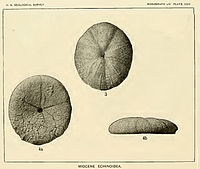
,%20apical,%20Miocene,%20Santa%20Margarita%20sandstone,%20San%20Luis%20Obispo,%20Californie,%20USA,%2051%20mm.jpg)
,%20apical,%20Miocene,%20Santa%20Margarita%20sandstone,%20San%20Luis%20Obispo,%20Californie,%20USA,%2038%20mm.jpg)
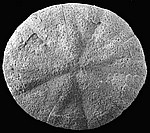
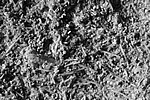

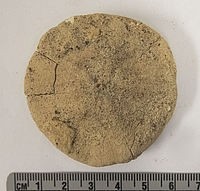
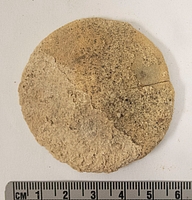

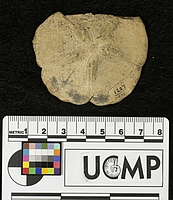

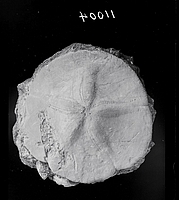
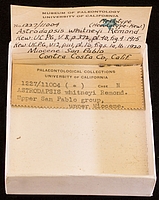


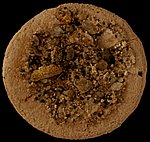
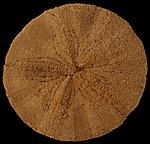
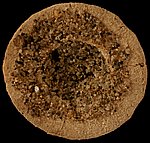
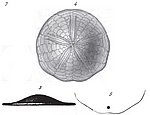


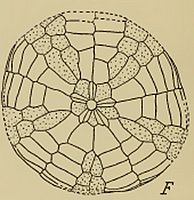

,%20apical,%20Maioli,%20Taiwan,%20Pléistocène,%2010%20mm.jpg)
,%20oral,%20Maioli,%20Taiwan,%20Pléistocène,%2010%20mm.jpg)


